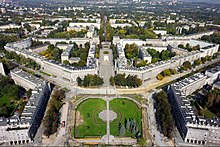Nowa Huta

Nowa Huta [ 'nɔva' xuta ] ( German New Hut ) is a district of Krakow ( Poland ).
The working-class district in the east of Krakow has around 194,000 inhabitants (2019) with additional prefabricated housing estates. The city was founded in 1949 as the site of an iron and steel combine and was incorporated into Kraków in 1951 as part of the Mogiła municipality. The city district of the same name was created until 1954 and comprised rich former villages and new prefabricated housing estates (osiedla) in the northeast of Krakow. In 1991 it was divided into five boroughs.
The plans for the construction of Nowa Huta existed before the Soviet influence, but due to the favorable road and rail connections to the Ukraine and the rest of the Soviet Union , the location east of Krakow was ultimately favored compared to the Polish idea of a location closer to Silesia Construction supported by the Council for Mutual Economic Aid with the equivalent of US $ 450 million.
In addition to economic purposes, this new founding also fulfilled political purposes: the communist regime of Poland wanted to create a new workers' center near the Catholic-conservative Krakow, which rejected the new system. Nowa Huta was a planned city of the socialist follow ideology. The floor plan of the city, which has five main avenues radiating from a central square according to the absolutist goosefoot pattern (French: patte d'oie ), testifies to the similarity of the Stalinist building gesture with the princely representation of absolutism. The construction quality of the first building phase can be described as good compared to later prefabricated housing estates, there is a certain similarity to the Viennese municipal housing of the Red Vienna of the interwar period and to the neoclassicism of the 1930s. Most of the buildings in Nowa Huta were built in the style of socialist classicism .
There are still social conflicts between the intellectual Krakow and the working people in Nowa Huta. Despite the good and fast connection to the center of Krakow, residents of Nowa Huta only visit Krakow an average of twice a year; The reason for this is that Nowa Huta was planned as a separate city and therefore has all the supply facilities.
Building history
Nowa Huta was built in the shape of a half-octagon with a central square from which four main streets and an avenue for pedestrians (Aleja Róż) branch off.
church
The town became famous through the dispute over the building of a church in Bieńczyce. The communist regime wanted a religion-free city; The then Archbishop of Kraków and later Pope Karol Wojtyła , however, achieved completion in 1977 in protracted, passive resistance.
The architectural shape of the church symbolizes Noah's Ark stranded on Mount Ararat and is modeled on the Notre Dame du Haut church by Le Corbusier in Ronchamp . The architect of the church is Wojciech Pietrzyk. Jan Jargon was in charge of organ building .
additional
The Nowa Huta tram depot went into operation in 1965.
politics and society
Nowa Huta was also a scene of struggles critical of socialism in the first decade after its foundation. These sparked off in particular in the disputes about the building of the church, but also took up other social issues. The 1970s were the economically most successful years in Nowa Huta, when the increase in steel production had a positive effect on employment and the standard of living of workers. As a result of the political events following the emergence of Solidarność in Poland since the beginning of the 1980s and in particular the economic restructuring and devaluation of industrial work after 1989, a dissolution of the grown social structures can be observed in Nowa Huta.
gallery
literature
- Robert Schediwy: City Images - Reflections on Change in Architecture and Urbanism , Vienna 2005 (especially p. 157ff)
art
- Tassilo Blittersdorff : "Nowa Huta and changing photos", Vienna 2004
See also
Web links
- Page from Nowa Huta, (Polish)
- Text about alienating photos in Nowa Huta
- Results of the socio-geographic studies on Nowa Huta by Dr. Alison Stenning from Newcastle University
Individual evidence
- ↑ R. Tomczyk. Jan jargon. Diploma thesis 1998; Krakow Music Academy (Polish)
Coordinates: 50 ° 4 ′ 20 ″ N , 20 ° 2 ′ 15 ″ E











